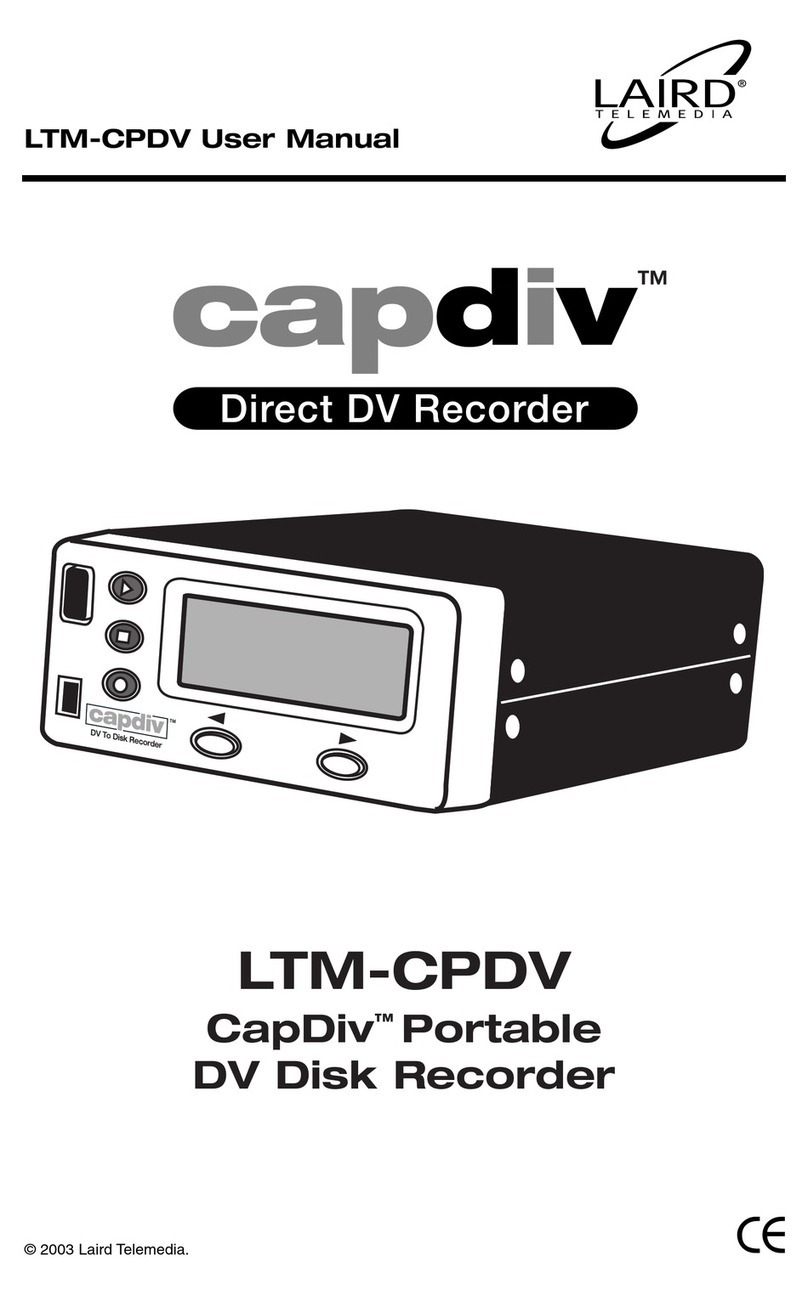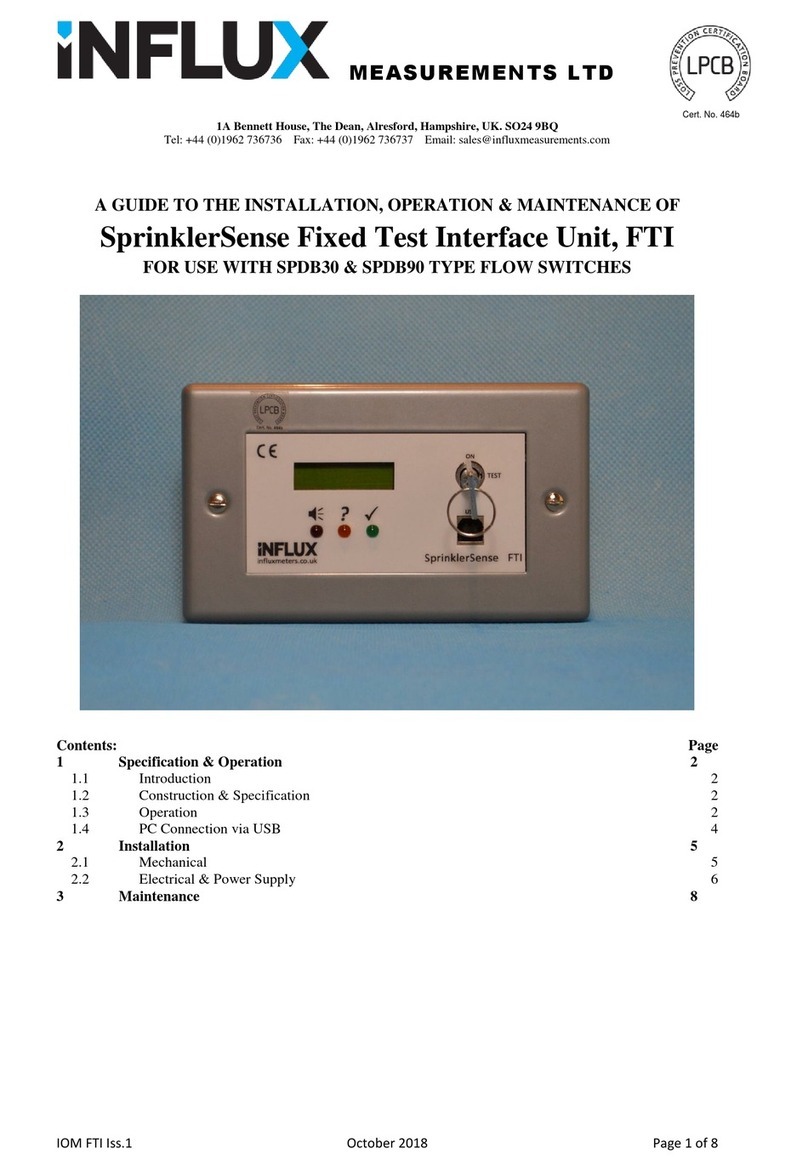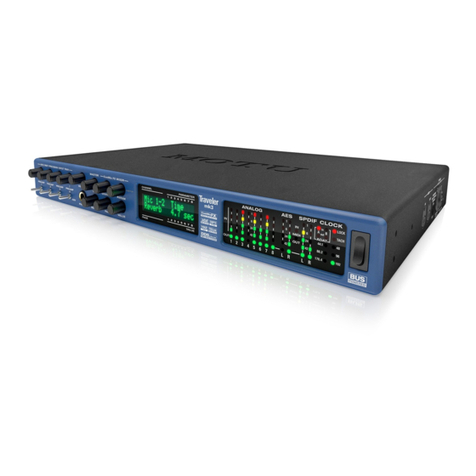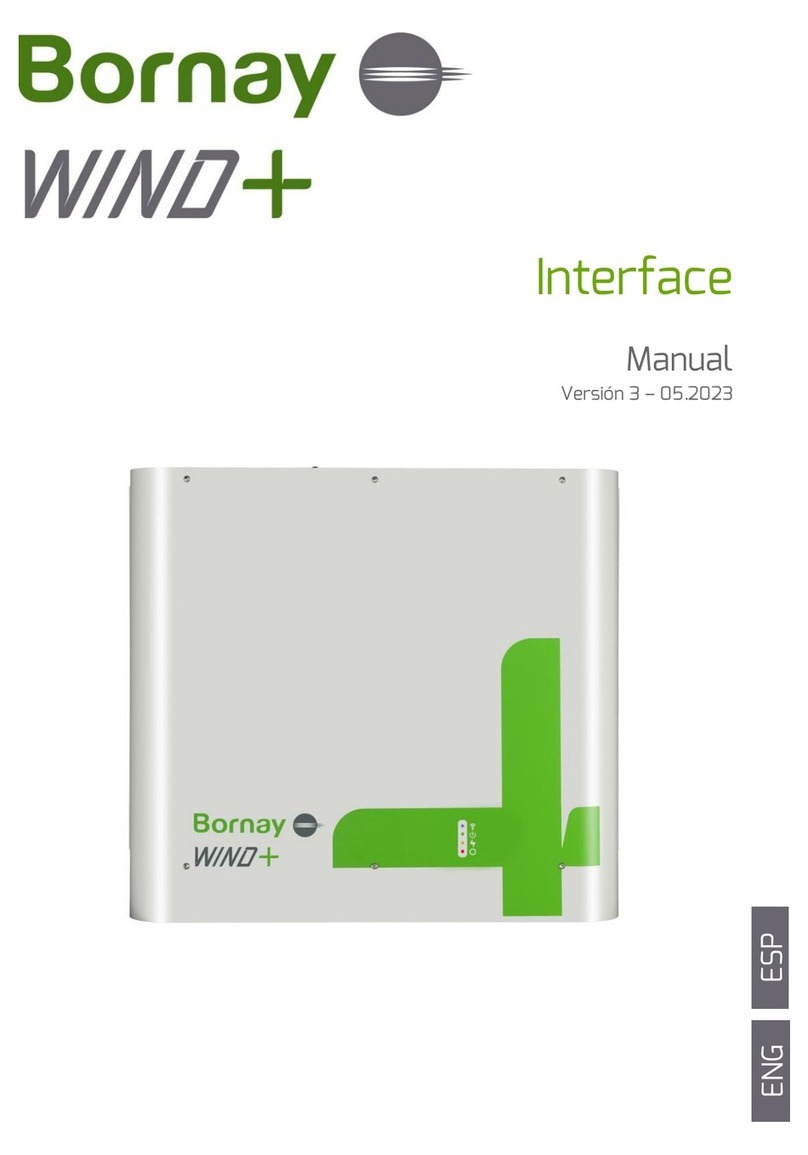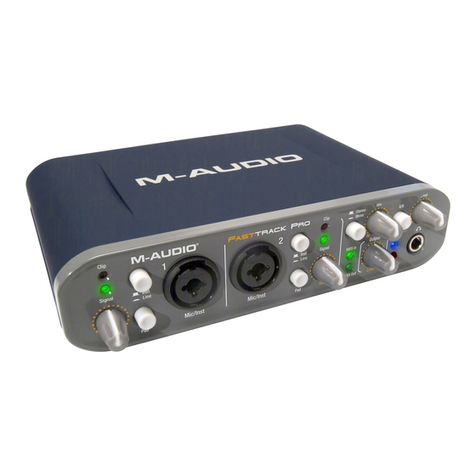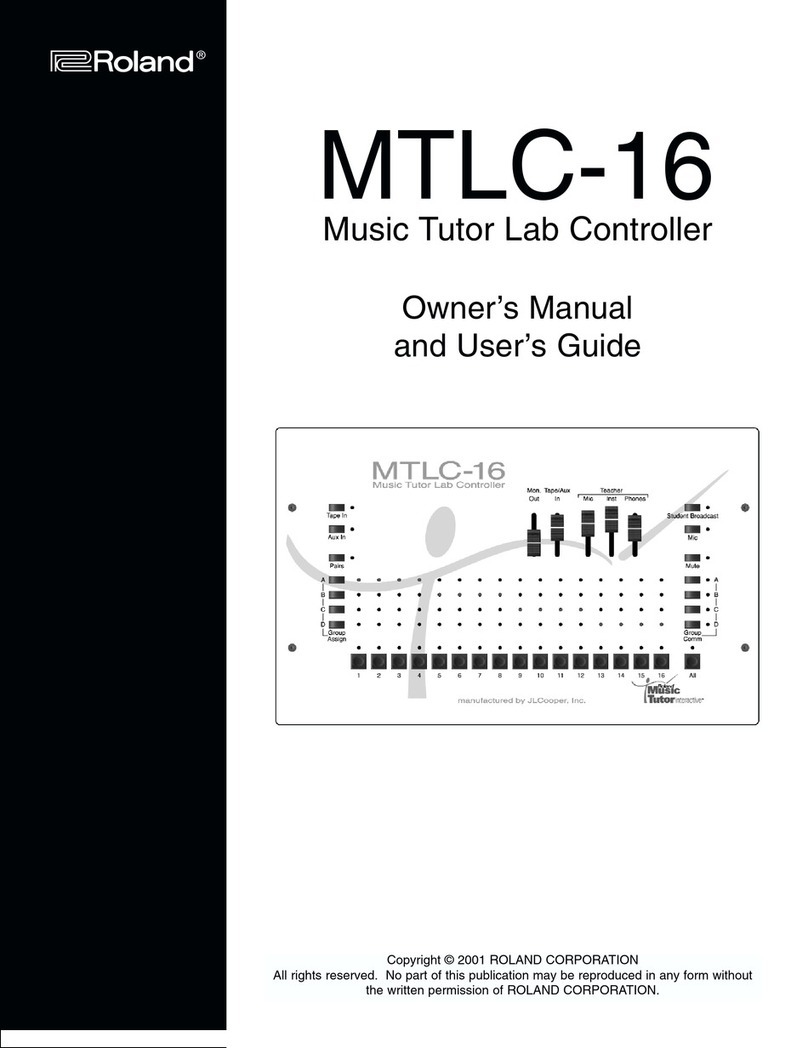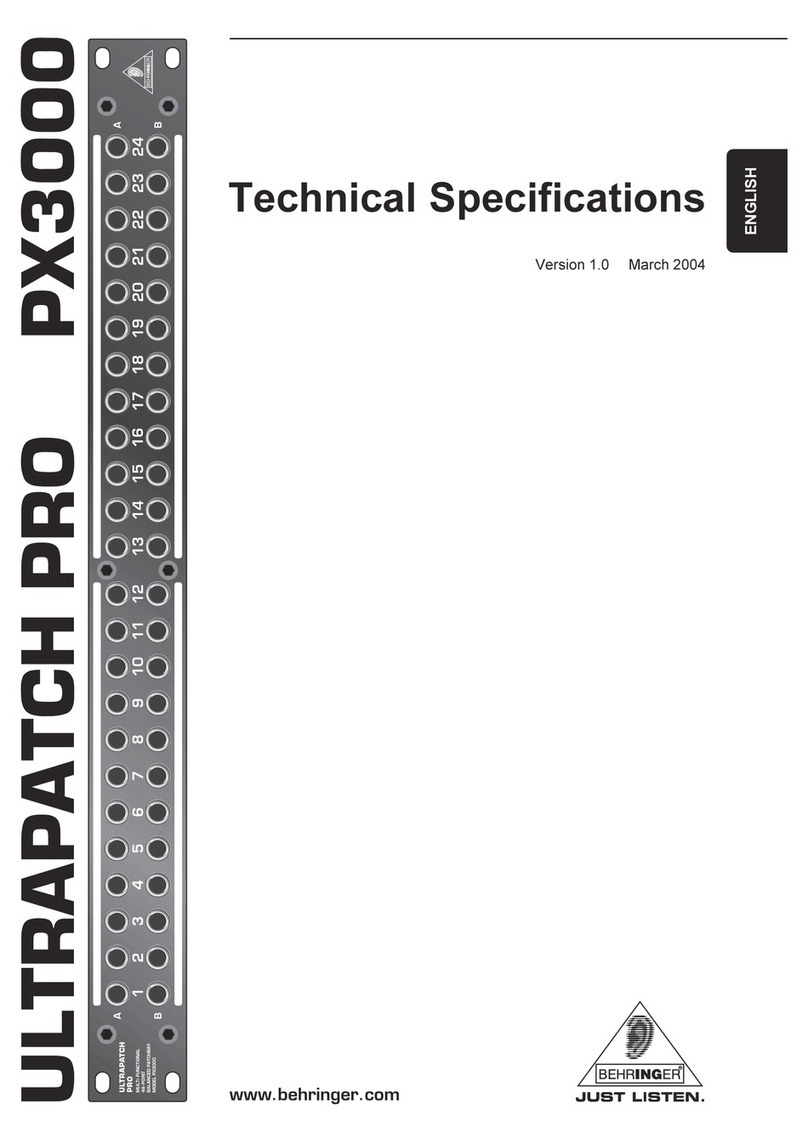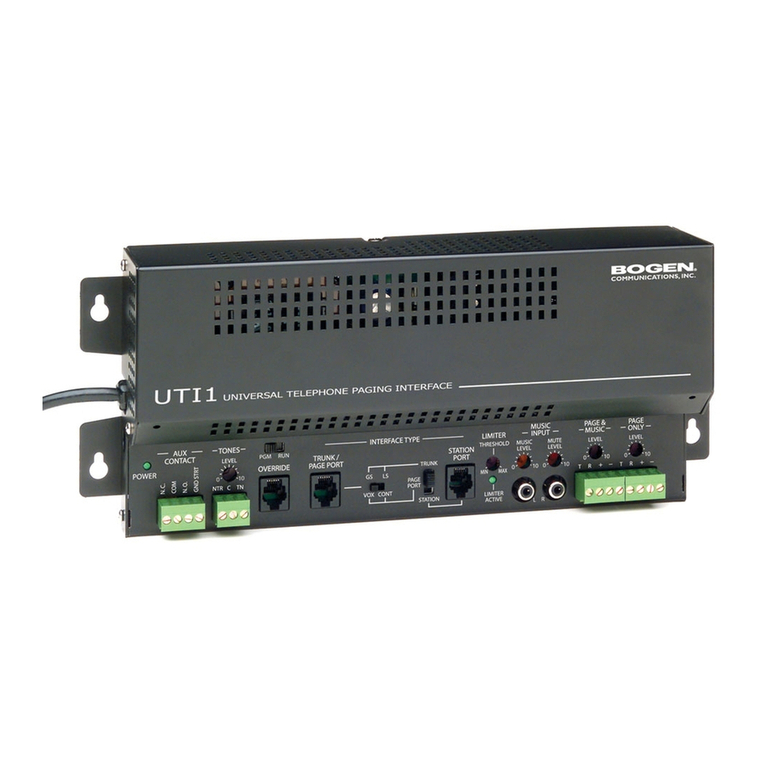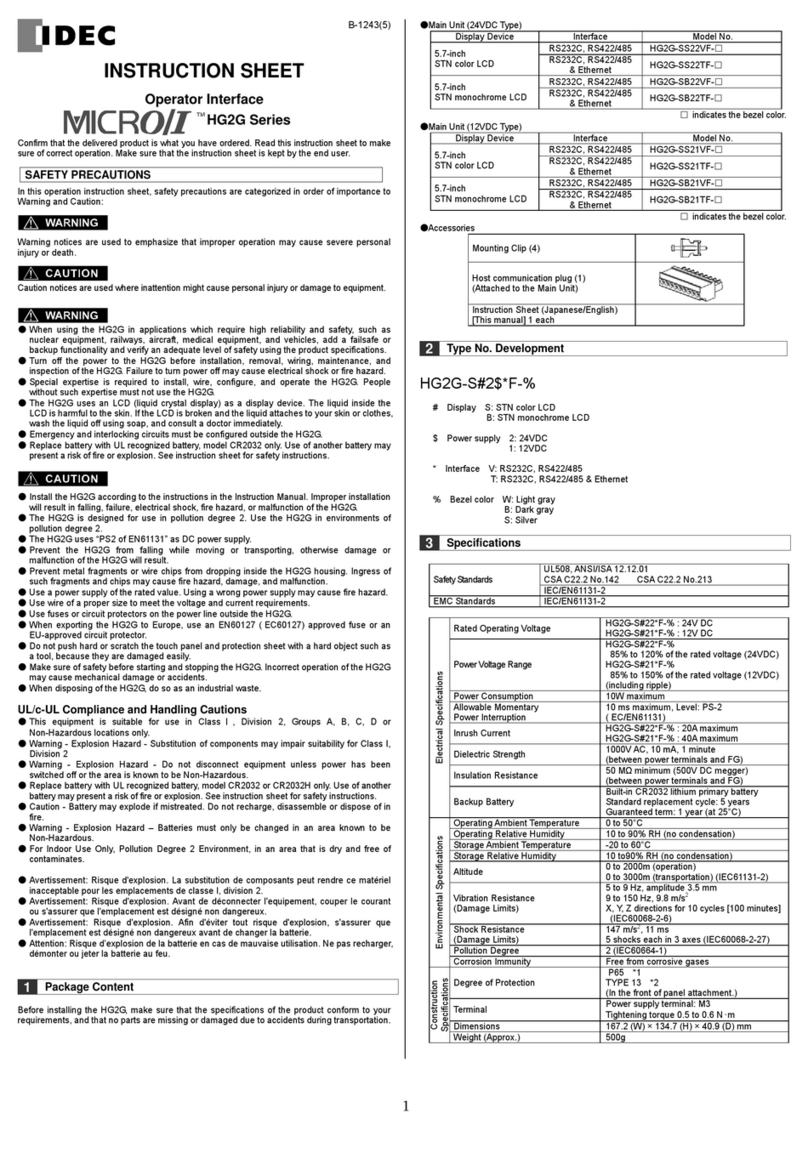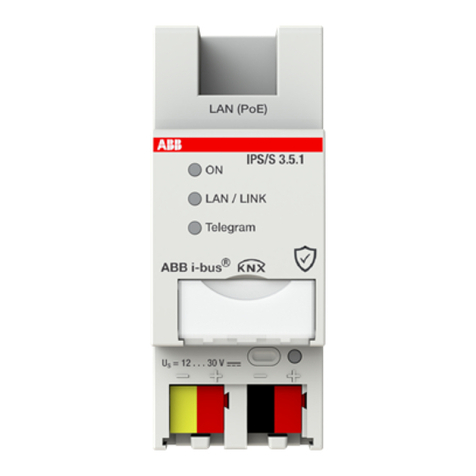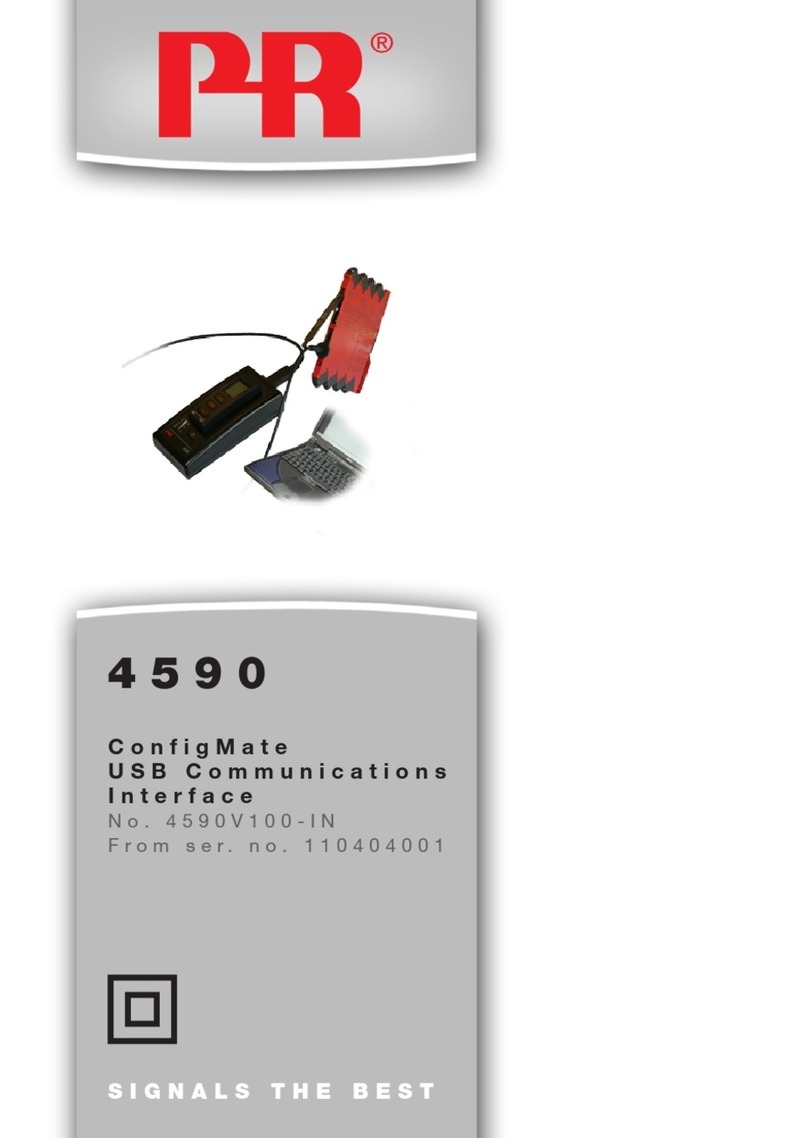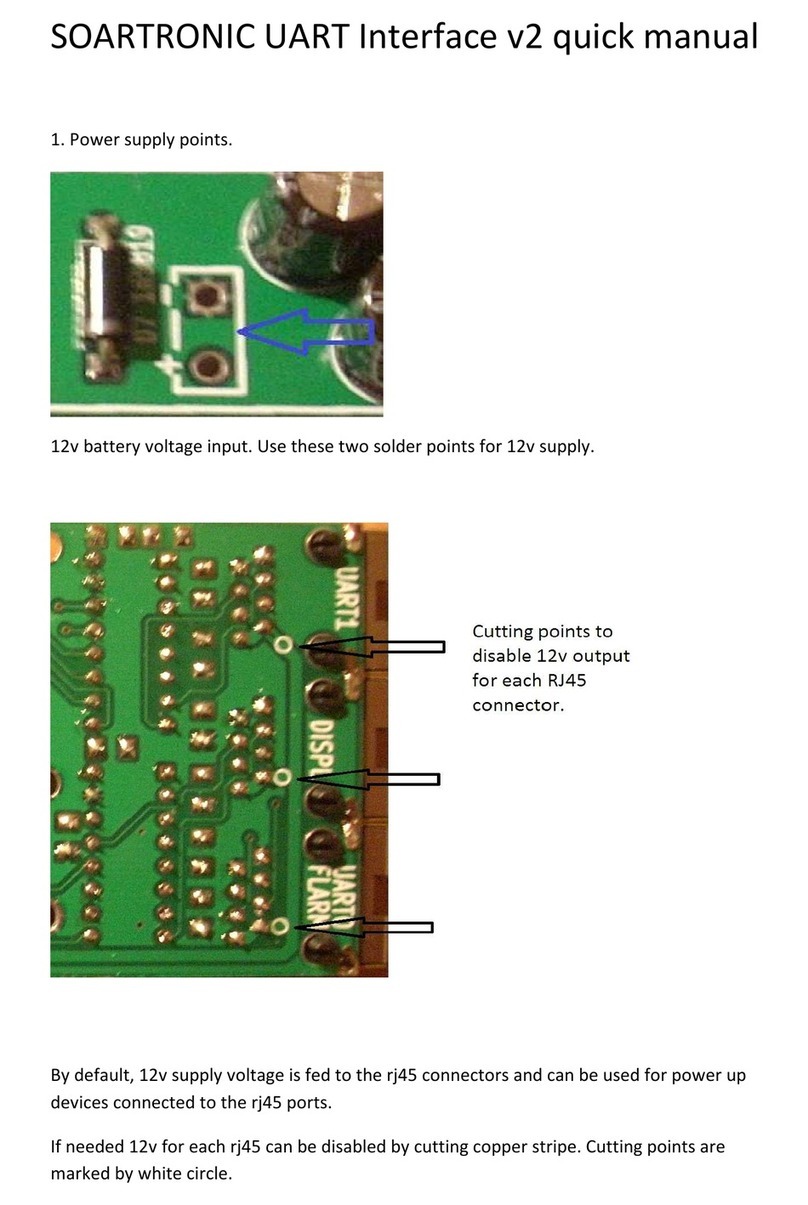Fuji Electric OPC-E1-CCL User manual

Instruction Manual
CC-Link Interface Option
"OPC-E1-CCL"
㩷
Thank you for purchasing our CC-Link Interface Card OPC-E1-CCL.
• This product is designed to connect the FRENIC-Multi series of inverters to CC-Link network. Read through
this instruction manual in conjunction with the FRENIC-Multi User's Manual and be familiar with the
handling procedure for correct use.
• Improper handling blocks correct operation or causes a short life or failure.
• Deliver this manual to the end user of the product. The end user should keep this manual in a safe place
until the CC-Link Interface Option is discarded.
• For the usage of inverters, refer to the instruction manual prepared for the FRENIC-Multi series of inverters.
Fuji Electric FA Components & Systems Co., Ltd.

Copyright © 2006 Fuji Electric FA Components & Systems Co., Ltd.
All rights reserved.
No part of this publication may be reproduced or copied without prior written permission from Fuji Electric FA
Components & Systems Co., Ltd.
All products and company names mentioned in this manual are trademarks or registered trademarks of their
respective holders.
The information contained herein is subject to change without prior notice for improvement.

Preface
Thank you very much for purchasing our CC-Link Interface Option "OPC-E1-CCL."
This manual has been prepared to help you connect your FRENIC-Multi to a CC-Link master (Mitsubishi Electric
sequencer, etc.) via CC-Link.
Mounting this option on your FRENIC-Multi allows you to connect the FRENIC-Multi to a CC-Link master and
control it as a slave using run command, speed command, and access to inverter's function codes.
This option has the following features:
• CC-Link Version: Complies with CC-Link versions 1.10 and 2.00
• Applicable Profile: Inverter (1 station occupied)
• Monitoring the status of the FRENIC-Multi (running status, frequency, output torque, output current, output
voltage and etc.)
• Reading and writing from/to function codes applicable to the FRENIC-Multi
Logo mark:
This option is a CC-Link version 2.00 compliant remote device unit and supports the following:
- Extended cyclic transmission
- Easing restrictions on inter-station cable length
This instruction manual does not contain inverter handling instructions. Read through this instruction manual in
conjunction with the FRENIC-Multi Instruction Manual (INR-SI47-1094-E) and be familiar with proper handling
and operation of this product. Improper handling might result in incorrect operation, a short life, or even a failure
of this product.
Keep this manual in a safe place.
Related Publications
Listed below are the other materials related to the use of the CC-Link Interface Option "OPC-E1-CCL." Read
them in conjunction with this manual as necessary.
• RS-485 Communication User's Manual (MEH448)
• FRENIC-Multi Instruction Manual (INR-SI47-1094-E)
The materials are subject to change without notice. Be sure to obtain the latest editions for use.
Safety precautions
Read this manual thoroughly before proceeding with installation, connections (wiring), operation, or
maintenance and inspection. Ensure you have sound knowledge of the device and familiarize yourself with all
safety information and precautions before proceeding to operate the inverter.
Safety precautions are classified into the following two categories in this manual.
Failure to heed the information indicated by this symbol may lead to
dangerous conditions, possibly resulting in death or serious bodily
injuries.
Failure to heed the information indicated by this symbol may lead to
dangerous conditions, possibly resulting in minor or light bodily injuries
and/or substantial property damage.
Failure to heed the information contained under the CAUTION title can also result in serious consequences.
These safety precautions are of utmost importance and must be observed at all times.㩷
1

Installation and wiring
• Turn the inverter's power OFF and wait for at least five minutes. Further, check that the DC link bus
voltage between the P (+) and N (-) terminals is lower than 25 VDC.
• Qualified electricians should carry out wiring.
Otherwise, electric shock could occur.
• Do not use the products that are damaged or lacking parts.
Doing so could cause a fire, accident, or injury.
• Prevent lint, paper fibers, sawdust, dust, metallic chips, or other foreign materials from getting into
the inverter and the option.
Otherwise, a fire or an accident might result.
• Incorrect handling in installation/removal jobs could cause a failure.
A failure might result.
• Noise may be emitted from the inverter, motor and wires. Implement appropriate measure to prevent
the nearby sensors and devices from malfunctioning due to such noise.
Otherwise, an accident could occur.
Operation
• Be sure to mount the inverter's and option's terminal covers before turning the inverter's power ON.
Do not remove the covers while power is applied.
Otherwise electric shock could occur.
• Do not operate switches with wet hands.
Doing so could cause electric shock.
• If you configure the function codes wrongly or without completely understanding FRENIC-Multi
Instruction Manual (INR-SI47-1094-E) and the FRENIC-Multi User's Manual (MEH457), the motor
may rotate with a torque or at a speed not permitted for the machine. Confirm and adjust the setting
of the function codes before running the inverter.
Otherwise, an accident could occur.
Maintenance and inspection, and parts replacement
• Turn the inverter's power OFF and wait for at least five minutes before starting inspection. Further,
check that the DC link bus voltage between the P (+) and N (-) terminals is lower than 25 VDC.
Otherwise, electric shock could occur.
• Maintenance, inspection, and parts replacement should be made only by qualified persons.
• Take off the watch, rings and other metallic objects before starting work.
• Use insulated tools.
Otherwise, electric shock or injuries could occur.
2

Disposal
• Treat the product as an industrial waste when disposing of it.
Otherwise injuries could occur.
Others
• Never attempt to modify the product.
Doing so could cause electric shock or injuries.
How this manual is organized
This manual is made up of chapters 1 through 12.
Chapter 1 BEFORE USING THE CC-Link INTERFACE OPTION
Lists points to be checked upon delivery of this option and describes the applicable inverters.
Chapter 2 NAMES AND FUNCTIONS
Shows the inside view of this option and describes the terminating resistor switch and LED status indicators.
Chapter 3 MOUNTING THE CC-Link INTERFACE OPTION
Provides instructions and precautions for mounting this option.
Chapter 4 WIRING AND CABLING
Provides wiring instructions around the terminal blocks on this option and the cable specifications.
Chapter 5 CONFIGURING INVERTER'S FUNCTION CODES FOR CC-Link COMMUNICATION
Describes the inverter's function codes to be set for the CC-Link communications link. Also this chapter lists the
related function codes.
Chapter 6 SETTING-UP PROCEDURE
Guides you to establish a CC-Link communications link.
Chapter 7 LIST OF I/O SIGNALS
Provides the details of remote I/O signals available for CC-Link communication.
Chapter 8 INVERTER REACTION TO CC-Link COMMUNICATIONS ERRORS
Describes on how the inverter operates if a CC-Link communications error occurs.
Chapter 9 ALARM CODE LIST
Lists and describes inverter’s alarm codes.
Chapter 10 APPLICATION PROGRAM EXAMPLES
Provides program examples that control the inverter by a sequencer.
Chapter 11 TROUBLESHOOTING
Provides troubleshooting instructions for certain problems, e.g., when the inverter does not operate as ordered
or when an alarm condition has been recognized.
Chapter 12 SPECIFICATIONS
Lists the general specifications and communications specifications.
3

Icons
The following icons are used throughout this manual.
This icon indicates information which, if not heeded, can result in the product not operating to full
efficiency, as well as information concerning incorrect operations and settings which can result in
accidents.
This icon indicates information that can prove handy when performing certain settings or operations.
This icon indicates a reference to more detailed information.
Table of Contents
Preface .......................................................................... 1
How this manual is organized .............................................. 3
Chapter 1 BEFORE USING THE CC-Link INTERFACE
OPTION............................................................. 5
1.1 Acceptance Inspection ............................................ 5
1.2 Applicable Inverters................................................. 5
Chapt r 2 NAMES AND FUNCTIONS ............................... 6e
2.1 Parts Names ........................................................... 6
2.2 Terminating Resistor Switch .................................... 6
2.3 LED Status Indicators.............................................. 7
2.4 RJ-45 Connector ..................................................... 8
2.5 Power Supply Terminal Block and CC-Link
Terminal Block......................................................... 8
Chapter 3 MOUNTING THE CC-Link INTERFACE
OPTION............................................................. 9
Chapt r 4 WIRING AND CABLING .................................. 13e
4.1 Basic Connection Diagram.................................... 13
4.2 Wiring for Power Supply Terminal Block................ 14
4.3 Wiring for CC-Link Terminal Block......................... 15
4.4 ON/OFF Timing of the Option and the Inverter...... 17
Chapter 5 CONFIGURING INVERTER'S FUNCTION
CODES FOR CC-Link COMMUNICATION ..... 18
Chapter 6 SETTING-UP PROCEDURE........................... 19
Chapter 7 LIST OF I/O SIGNALS..................................... 20
7.1 Remote I/O Signals............................................... 20
7.2 Remote Registers ................................................. 22
7.3 List of Monitor Item Codes .................................... 26
7.4 Command Codes and Response Codes............... 27
Chapter 8 ..INVERTER REACTION TO CC-Link
COMMUNICATIONS ERRORS ....................... 29
Chapter 9 LIST OF INVERTER ALARM CODES ............. 30
Chapte 10 APPLICATION PROGRAM EXAMPLES.......... 31r
10.1 System Configuration........................................... 31
10.2 Network Parameter Settings ................................ 31
10.3 Relationship between Master Station Device
and Remote I/O and Remote Register................. 32
10.4 CC-Link Startup Program..................................... 33
10.5 Program Example Using the Inverter Running
Status Read ......................................................... 33
10.6 Program Example for Changing the Operation
Mode.................................................................... 34
10.7 Program Example for Specifying Run Command. 34
10.8 Program Example for Monitoring the Output
Frequency............................................................ 35
10.9 Program Example for Reading from the
erter's Function Code Data ............................. 35Inv
10.10 Program Example for Writing to Inverter's
unction Code Data ............................................. 36F
10.11 Program Example for Setting up the Reference
equency............................................................ 37Fr
10.12 ogram Example for Reading out Alarm Codes . 38Pr
10.13 Program Example for Resetting a Inverter Trip.... 38
Chapter 11 TROUBLESHOOTING..................................... 39
Chapte 12 SPECIFICATIONS ........................................... 40r
12.1 General Specifications ......................................... 40
12.2 CC-Link Specifications......................................... 40
4

Chapter 1 BEFORE USING THE CC-Link INTERFACE OPTION
1.1 Acceptance Inspection
Unpack the package and check the following:
(1) A CC-Link interface option and the following accessories are contained in the package. (See Figure 1.1.)
- Two option connection cables
(A short one for inverters with a capacity of 3.7 kW or below and a long one for inverters with a capacity
of 5.5 kW or above)
- One option fixing screw
- CC-Link Interface Option Instruction Manual (this manual)
(2) The option and accessories have not been damaged during transportation—there should be no dents or
parts missing.
(3) The model name "OPC-E1-CCL" is printed on the nameplate attached to the right side of the option. (See
Figure 1.1.)
If you suspect the product is not working properly or if you have any questions about your product, contact your
Fuji Electric representative.
Figure 1.1 CC-Link Interface Option and Accessories
1.2 Applicable Inverters
The CC-Link interface option is applicable to the following inverters and ROM version.
Table 1.1 Applicable Inverters and ROM Version
Series Inverter type Applicable motor rating ROM version
FRENIC-Multi FRNE1- All capacities Version 0700 or later
To check the inverter's ROM version, use Menu #5 "Maintenance Information" on the keypad. (Refer to the
FRENIC-Multi Instruction Manual (INR-SI47-1094-E), Chapter 3, Section 3.4.6 "Reading maintenance
information."
Display on LED Monitor Item Description
A
Inverter's ROM version Shows the inverter's ROM version as a 4-digit code.
5

Chapter 2 NAMES AND FUNCTIONS
2.1 Parts Names
Figure 2.1 shows the inside view of the CC-Link interface option with its terminal cover (See Figure 3.3)
removed.
Figure 2.1 Parts Names of CC-Link Interface Option
2.2 Terminating Resistor Switch
The CC-Link communications network requires insertion of line terminating resistors at its both ends. When this
option is mounted on the inverter at either end of the network, turn this switch ON to insert the terminating
resistor.
ON OFF
ON OFF
OFF: No insertion of terminating resistor ON: Insertion of terminating resistor
Figure 2.2 Terminating Resistor Switch Settings
6

2.3 LED Status Indicators
This option has five LED status indicators shown below. They indicate the operation status of the option as listed
in Table 2.1.
L.RUN RUN L.ERR SD RD
Figure 2.3 LED Status Indicators
Table 2.1 LED Indications and Operation Status
LED States
L.RUN RUN L.ERR SD RD Operation Status
zz{zzNormally communicating.
zz
zNormally communicating. But sometimes a CRC error
occurs due to electrical noise.
zz
{zReceived data contains a CRC error, so this option
cannot respond.
zz{{zData destined for this station does not come.
{zz
Responding to polling. But refresh data received
contains a CRC error.
The inverter trips with alarm
GT
displayed. *1
{z{zData destined for this station contains a CRC error.
The inverter trips with alarm
GT
displayed. *1
{z{z
Station address incorrectly specified.
Data destined for this station cannot be received due
to electrical noise.
{zz{z/{Transmission speed (Baud rate) and/or station
address out of the allowable range.
zz
(at 0.8-second
intervals)
zTransmission speed (Baud rate) or station address
changed during CC-Link communication.
{z{{{
This option cannot receive data due to broken wires,
etc.
The inverter trips with alarm
GT
displayed. *1
{
(at 0.4-second
intervals)
{{{
The master station is compliant with CC-Link version
1.xx and this slave station, with CC-Link version 2.xx.
Or the inverter's function code o30 is set to "5 to 255."
The inverter trips with alarm
GT
displayed.
{
(at 0.2-second
intervals)
{{{
During normal communication, the option connection
cable has been broken or the power to the inverter has
been cut OFF.
If the cable has been broken, the inverter trips with
alarm
GT
displayed.
{
(at 50 ms
intervals)
z{{
When this option is turned ON, the inverter has been
OFF or the option connection cable has been
disconnected.
{{
{{{
This option is OFF or broken.
If the inverter power is ON, it trips with alarm
GT
displayed.
z: ON, {: OFF, : Blinking (It may seem to be ON depending on the current transmission speed.)
*1Alarm
GT
occurs when a communications error is detected after a normal communications link has been
established once.
It is possible to change the
GT
occurrence conditions with inverter's function codes. For details, refer to
Chapter 8 "INVERTER REACTION TO CC-Link COMMUNICATIONS ERRORS."
7

2.4 RJ-45 Connector
The RJ-45 connector is used to connect the keypad of the FRENIC-Multi to this option.
The keypad can be detached from the option and mounted on a panel. For details, refer to the
FRENIC-Multi Instruction Manual (INR-SI47-1094-E), Chapter 2, Section 2.4 "Mounting and Connecting a
Keypad."
2.5 Power Supply Terminal Block and CC-Link Terminal Block
The power supply terminal block and CC-Link terminal block are used to connect the 24V power cable and
CC-Link cable, respectively, in order to operate this option.
For details, refer to Chapter 4 "WIRING AND CABLING."
8

Chapter 3 MOUNTING THE CC-Link INTERFACE OPTION
Turn the inverter's power OFF and wait for at least five minutes. Further, check that the DC link bus voltage
between the P (+) and N (-) terminals is lower than 25 VDC.
Otherwise, electric shock could occur.
• Do not use the products that are damaged or lacking parts.
Doing so could cause a fire, accident, or injury.
• Prevent lint, paper fibers, sawdust, dust, metallic chips, or other foreign materials from getting into
the inverter and the option.
Otherwise, a fire or an accident might result.
• Incorrect handling in installation/removal jobs could cause a failure.
• When handling this option, take any antistatic measure or hold the plastic parts taking care not to
directly touch the circuit board; otherwise, the static electricity charged in your body may damage it.
A failure might result.
9

Before mounting the option, perform the wiring for the main circuit terminals and control circuit
terminals.
(1) Remove the terminal cover from the inverter.
Note: For inverters with a capacity of 5.5 to 15 kW, you need to remove the terminal cover fixing screw to
remove the terminal cover.
For details on how to remove the terminal cover, refer to the FRENIC-Multi Instruction Manual
(INR-SI47-1094-E), Chapter 2, Section 2.3 "Wiring."
(2) Connect the option connection cable to the CN1 connector on the interface printed circuit board (interface
PCB) on the inverter.
Use the short cable for inverters with a capacity of 3.7 kW or below, and the long cable for the ones with a
capacity of 5.5 kW or above.
(3) Mount the terminal cover.
For details on how to mount the terminal cover, refer to the FRENIC-Multi Instruction Manual
(INR-SI47-1094-E), Chapter 2, Section 2.3 "Wiring."
(4) Push the hooks provided on both sides of the keypad and pull the keypad up and out of the inverter.
For details on how to remove the keypad, refer to the FRENIC-Multi Instruction Manual
(INR-SI47-1094-E), Chapter 2, Section 2.4 "Mounting and Connecting a Keypad."
Figure 3.1 Connecting the Option Connection Cable to the Interface PCB and Removing the Keypad
(For inverters with a capacity of 11 and 15 kW)
10

(5) Mount the option on the inverter, making the RJ-45 connector on the back side of the option engage with
the RJ-45 connector on the inverter (to which the keypad had been connected).
(6) Connect the keypad to the RJ-45 connector on the front side of the option, then secure the keypad and
option to the inverter with the option fixing screw (that comes with the option).
When using the keypad at a remote site, secure the option without the keypad to the inverter with the
screw.
Tightening torque: 0.6 N·m
Take care not to tighten the option fixing screw too much. Doing so could make the screw defective.
Figure 3.2 Mounting the CC-Link Interface Option and the Keypad
11

(7) Slightly pull the bottom of the option terminal cover towards you and remove it downward.
(8) Connect the other end of the option connection cable (whose end has been connected to the interface PCB
on the inverter in step (2) above) to the CN1 connector on the interface option printed circuit board
(interface option PCB).
(9) Mount the option terminal cover.
First fit the bosses on the top of the cover into the square holes provided in the option, and then push the
bottom of the cover until it snaps into place.
Figure 3.3 Connecting the Option Connection Cable to the Interface Option PCB
12

Chapter 4 WIRING AND CABLING
• Before starting installation, turn the inverter's power OFF and wait for at least five minutes. Further,
check that the DC link bus voltage between the P (+) and N (-) terminals is lower than 25 VDC.
• Qualified electricians should carry out wiring.
Otherwise, electric shock could occur.
The inverter, motor, and wiring emit electrical noise. Take appropriate measures to prevent the nearby
sensors and devices from malfunctioning due to such noise.
Otherwise, an accident could occur.
4.1 Basic Connection Diagram
L1/R U
V
W
L2/S
L3/T
G
FRENIC-Multi
OPC-E1-CCL
0V
24V
DB
DA
DG
SLD
FG
CC-Link cable
CC-Link
terminal block
Power supply
terminal block
Motor
G
M
To CC-Link network
E
24 VDC
power
supply
Terminating
resistor switch Blue
White
Yellow
G
Figure 4.1 Basic Connection Diagram
For the 24 VDC power supply to be connected to the power supply terminal block, be sure to use an
external 24 V power supply with a capacity of at least 150 mA. Never use the PLC terminal on the inverter;
doing so flows a current exceeding the capacity of the PLC terminal, resulting in a damaged inverter.
A failure might result.
13

4.2 Wiring for Power Supply Terminal Block
This terminal block is used to supply this option with 24 V power to operate it. Perform wiring for the terminal
block as described blow.
For the 24 VDC power supply to be connected to the power supply terminal block, be sure to use an
external 24 V power supply with a capacity of at least 150 mA. Never use the PLC terminal on the inverter;
doing so flows a current exceeding the capacity of the PLC terminal, resulting in a damaged inverter.
A failure might result.
(1) Wiring for the power supply terminal block (TERM3)
The terminal block uses a pluggable 3-pin connector as shown in Figure 4.2. Table 4.1 shows the pin
assignment.
A typical connector that matches this terminal block is Phoenix Contact MSTB 2.5/3-ST-5.08.
Table 4.1 Pin Assignment on Power Supply Terminal Block
Figure 4.2 Connectors on the Power
Supply Terminal Block
1 2 3
Pin # Terminal
name Description Remarks
1 24 V Power supply
(24 VDC, + side)
2 0 V Power supply
(24 VDC, - side)
Never use the PLC terminal
on the inverter for 24 V
power.
3 E Grounding
terminal
Connect the ground
terminal of the inverter
(G) to this terminal.
For protection against external noise and prevention of failures, be sure to connect a grounding
wire.
Table 4.2 lists the recommended wire size, terminal screw size and its tightening torque.
Table 4.2 Recommended Wire Size, Terminal Screw Size, and Its Tightening Torque
for the Power Supply Terminal Block
Wire size Terminal screw size Tightening torque
AWG20 to AWG16 (0.5 to 1.5 mm2),
wire with rated temperature 105qC (UL) recommended M3 0.5 to 0.6 N·m
⚂
OO
㔚✢
A
pprox.
6.0 mm
Cable wire
Figure 4.3 Recommended Strip Length of the Cable Wire End
for Terminal Connection
14

(2) Input power requirements
Select the 24 V input power supply that meets the specifications listed in Table 4.3.
Table 4.3 Input Power Requirements
Item Specifications
Input power voltage range 21.6 to 27.0 V
Power consumption Maximum 150 mA
4.3 Wiring for CC-Link Terminal Block
(1) To connect this option to a CC-Link network, use a CC-Link dedicated cable complying with the CC-Link
specifications. Using a cable other than a CC-Link dedicated cable does not assure the CC-Link system
performance. Also observe the wiring lengths specified in the CC-Link version 1.10 specifications.
The recommended CC-Link cable is FANC-110SBH made by Kuramo Electric Co., Ltd.
For details about wiring for CC-Link, refer to the CC-Link Master Use's Manual or CC-Link Cable Wiring
Manual published by the CC-Link Partner Association. The CC-Link Cable Wiring Manual is available as a
free download from the CC-Link Partner Association's website at:
http://www.cc-link.org/eng/t_html/siryo.html
(2) Wiring around the CC-Link terminal block
The terminal block uses a pluggable 5-pin connector as shown in Figure 4.4. Table 4.4 shows the
correspondence between the pin numbers and the ID colors.
A typical connector that matches this terminal block is Phoenix Contact MSTB 2.5/5-ST-5.08 AU.
The Phoenix Contact TMSTBP 2.5/5-ST-5.08 AU and TFKC 2.5/5-STF-5.08 AU (spring-cage
connection type) connectors for multidrop connection are also usable. Note that, however, the
former can be used only for FRENIC-Multi with a capacity of 3.7 kW or below.
Table 4.4 Layout of Terminal Pins
Terminal
Pin Name
ID Color of
Wire Sheath Description Remarks
DA Blue
DB White
DG Yellow
For
communication
data
SLD Metallic For shielded
wire
This is internally
connected with
terminal FG.
FG --- For grounding
Connect the ground
terminal of the inverter
(G) to this terminal.
㪝㪞 㪪㪣㪛 㪛㪞 㪛㪙 㪛㪘
Figure 4.4 Connectors on the
CC-Link Terminal Block
15

Table 4.5 lists the recommended terminal screw size and its tightening torque, and Figure 4.5 shows the
recommended strip length of the cable wire end.
⚂
OO
㔚✢
Cable wire
A
pprox.
6.0 mm
Table 4.5 Recommended Tightening Torque of the
Terminal Screws on the CC-Link Terminal Block
Terminal screw size Tightening torque
M3 0.5 to 0.6 N·m
Figure 4.5 Recommended Strip Length of the
Cable Wire End for Terminal
Connection
(3) When two or more inverters are connected
DA
DB
DG
SLD
FG
DA
DB
DG
SLD
FG
DA
DB
DG
SLD
FG
Master OPC-E1-CCL
CC-Link
cable
CC-Link
cable
Terminating
resistor Terminating resistor
(SW 5 = ON)
OPC-E1-CCL
*1
Figure 4.6 Connection Diagram of Two or More Inverters
*1On CC-Link interface options connected in the middle of the network, set their terminating resistor
switches (SW5) to OFF (No insertion of terminating resistor).
16

4.4 ON/OFF Timing of the Option and the Inverter
Observe the following instructions about the ON/OFF timing of this option and the inverter.
(1) Power ON
It is recommended that this option be turned ON at the same time as or before the inverter. Turning the
inverter ON first may detect no operation of the option, causing a trip with
GT
alarm. The
GT
alarm can
be reset after this option is turned ON.
(2) Power OFF
It is recommended that this option be turned OFF at the same time as or after the inverter. Turning the
option OFF first may cause the inverter to detect no operation of the option, causing a trip with
GT
alarm.
Turning the inverter OFF resets the
GT
alarm.
The inverter issues an alarm
GT
if the option's power stays OFF for approximately 1 second when the
inverter power is ON.
17

Chapter 5 CONFIGURING INVERTER'S FUNCTION CODES FOR CC-Link
COMMUNICATION
Before starting CC-Link communication between the inverter equipped with this option and the CC-Link master
device, configure the inverter's function codes listed in Table 5.1.
Table 5.2 lists other related function codes to be configured if necessary.
Table 5.1 Inverter's Function Codes for CC-Link Communication
(The underlined valuesare factory defaults.)
Function
code Function Setting range Description
o27 *1
Response mode to apply
when a CC-Link
communications error occurs
0to 15
Select a response mode to apply when a
communications link error or an option failure is
detected.
o28 *1
Operation timer to apply when
a CC-Link communications
error occurs
0.0 to 60.0 sec.
Specify the timer period during which the
inverter keeps running even if a communications
link error is detected.
0, 1 1 station occupied (CC-Link version 1.10)
21 station occupied, 2X setting
(CC-Link version 2.00)
31 station occupied, 4X setting
(CC-Link version 2.00)
41 station occupied, 8X setting
(CC-Link version 2.00)
o30 *2 CC-Link extension
5 to 255 No operation
1 to 64 Set a station address.
o31 *3 Station address 0, 65 to 255 Invalid
0156 kbps
1625 kbps
22.5 Mbps
35 Mbps
410 Mbps
o32 *3 Transmission speed
5 to 255 Invalid
*1 For details about the function codes o27 and o28, refer to Chapter 8 "INVERTER REACTION TO CC-Link
COMMUNICATIONS ERRORS."
*2 After changing the o30 data, resetting the option (by turning the terminal RST ON or by turning the option's power
OFF and then ON) validates the new setting. However, resetting the option causes an inverter trip with an alarm
GT
if Version 1.xx is specified on the master station and Version 2.xx on the option.
*3 Changing the o31 or o32 data causes the L.ERR LED to start blinking. Resetting the option validates the new setting
and turns the L.ERR LED OFF.
Table 5.2 Other Related Function Codes
Function
code Function Factory default Function code data Remarks
y98 *1 Run/frequency
command sources
0Select from the following choices:
Frequency
command
Run
command
0 Inverter Inverter
1 CC-Link Inverter
2 Inverter CC-Link
3 CC-Link CC-Link
If there is no
special problem
with your system,
setting y98 = 3 is
recommended.
*1 In addition to y98, there are some function codes that specify run/frequency command sources. Using those function
codes enables more flexible settings of run/frequency command sources. For details, refer to the description for the
function codes H30 and y98 in the FRENIC-Multi Instruction Manual (INR-SI47-1094-E), Chapter 5 "FUNCTION
CODES."
18
Table of contents
Other Fuji Electric Recording Equipment manuals
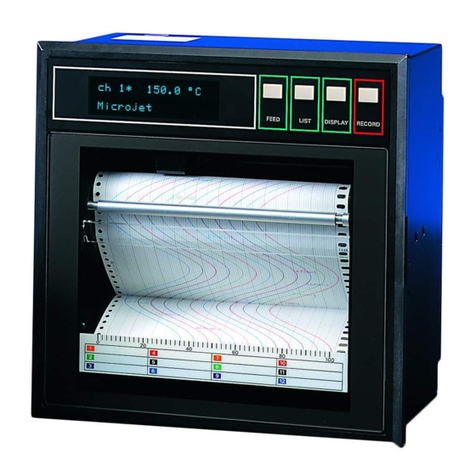
Fuji Electric
Fuji Electric PHA User manual

Fuji Electric
Fuji Electric OPC-VG1-PMPG User manual
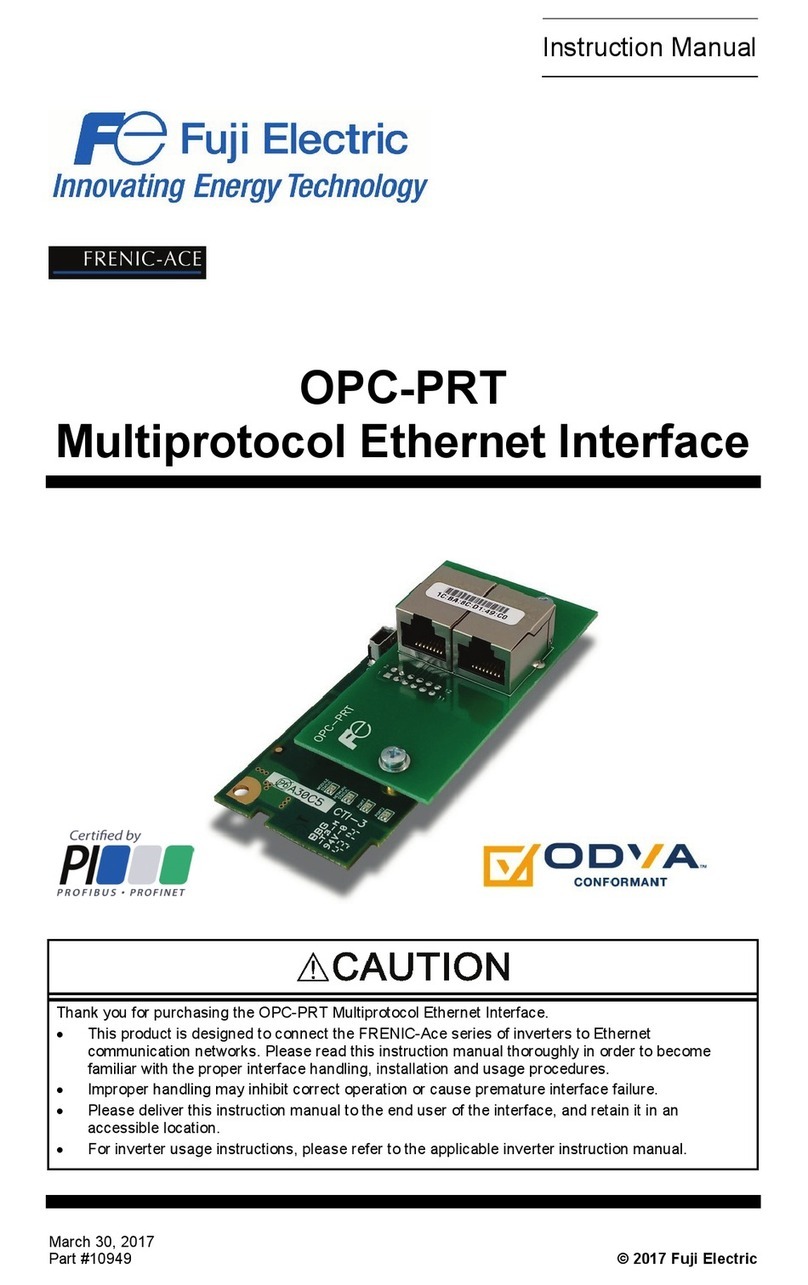
Fuji Electric
Fuji Electric OPC-PRT User manual
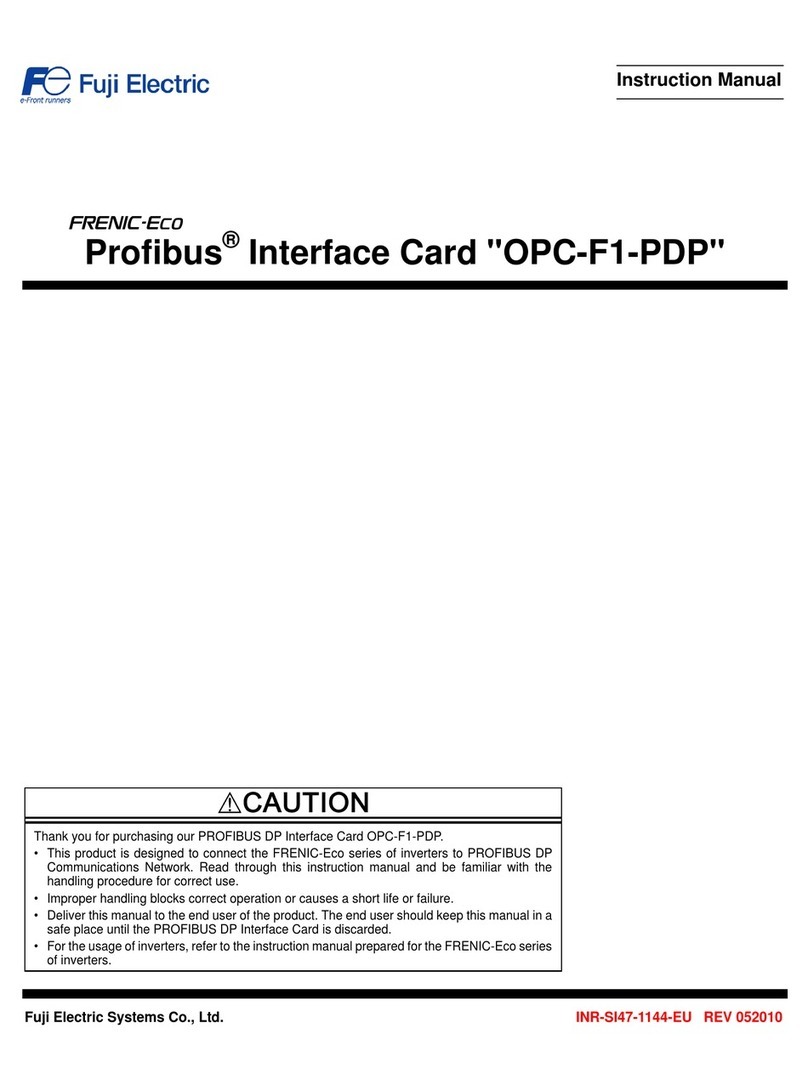
Fuji Electric
Fuji Electric Profibus OPC-F1-PDP User manual
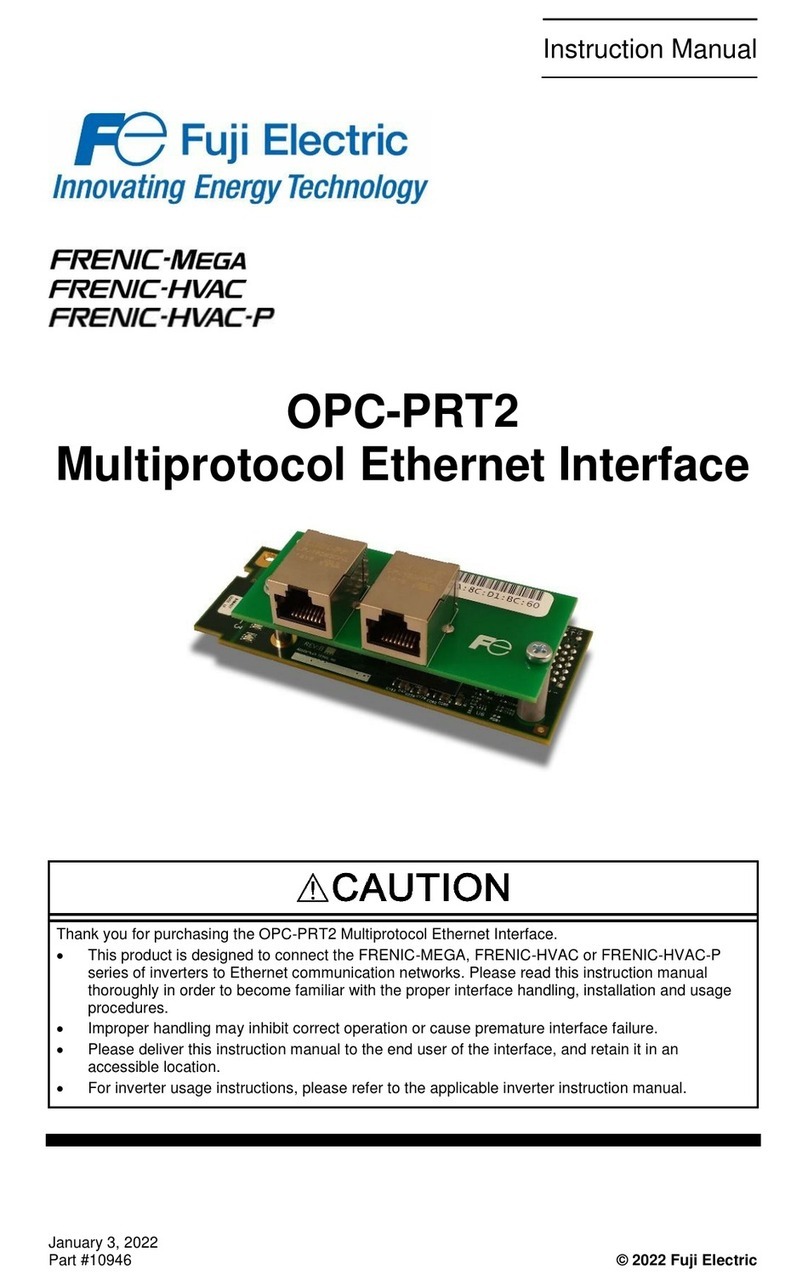
Fuji Electric
Fuji Electric OPC-PRT2 User manual
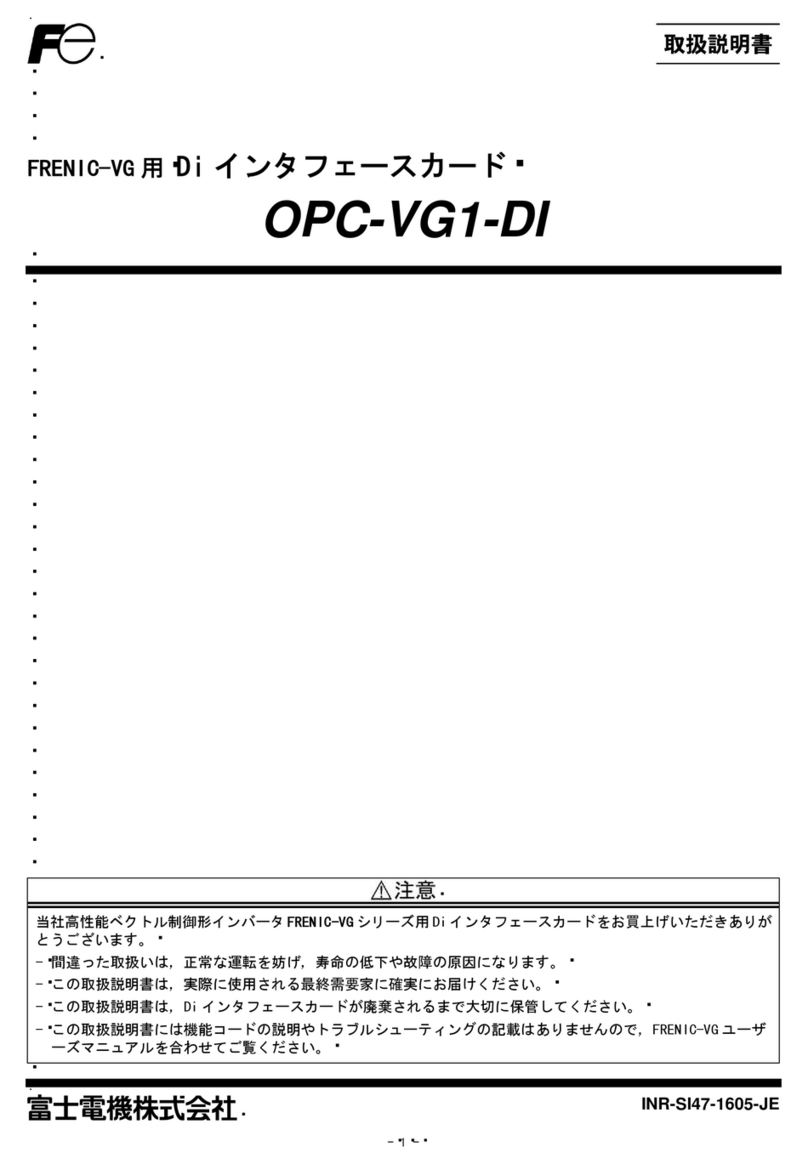
Fuji Electric
Fuji Electric OPC-VG1-DI User manual
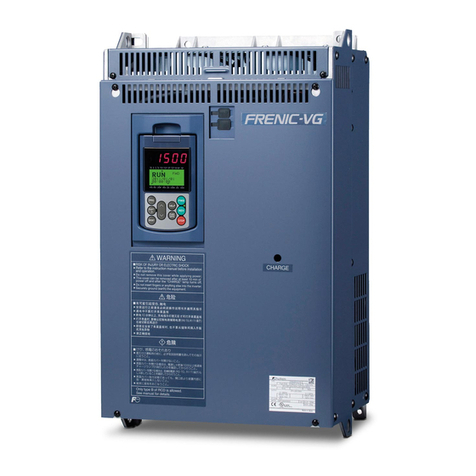
Fuji Electric
Fuji Electric OPC-VG1-TL User manual

Fuji Electric
Fuji Electric OPC-VG1-ESX User manual
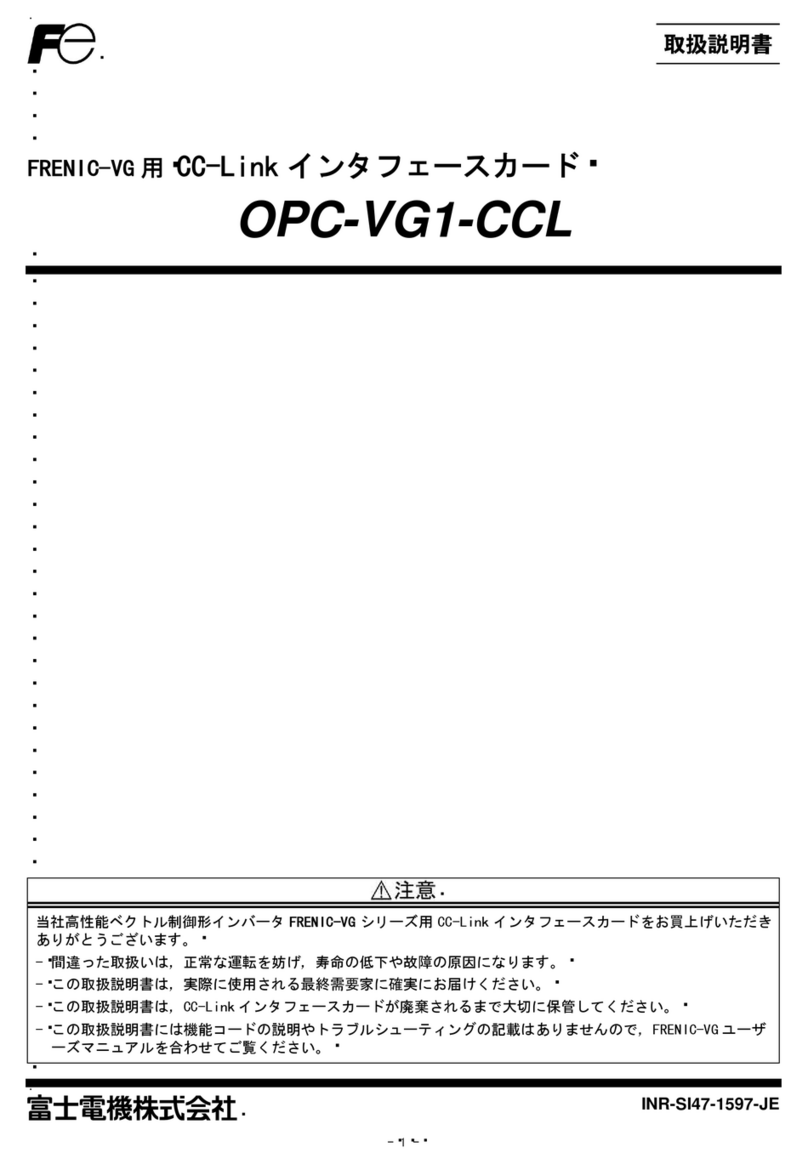
Fuji Electric
Fuji Electric OPC-VG1-CCL User manual

Fuji Electric
Fuji Electric OPC-VG1-PG User manual

